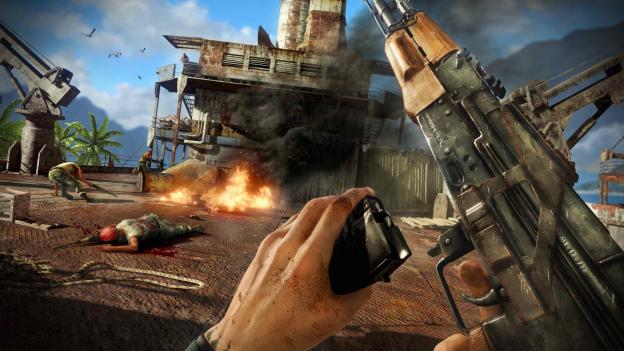
What is Far Cry?
I’ve asked that question many times. Far Cry the first is a first-person shooter set in a lush tropical environment. The game’s South Pacific archipelago offers wide expanses of space for players to stretch out in, but it’s not technically a true open world game. That’s what Far Cry 2 is, with the action staged against the backdrop of sociopolitical unrest in an unnamed African nation. The sequel excels at immersing players in the varied environments, with everything in the game — from shooting to driving to performing in-the-field first aid — locked in that first-person perspective. There’s an overarching narrative, but the real story in Far Cry 2 is the one that you write for yourself.
Now we’re looking ahead to Far Cry 3, which hits PlayStation 3, Xbox 360, and PC platforms on December 4, 2012. Ubisoft Montreal is bringing back the open world and the tropical environment, with the game’s everyman protagonist Jason Brody dropped into the middle of what amounts to a hornet’s nest. He’s unprepared in every way for the adventure that will be forced on him, and he’ll learn to survive in the game’s unforgiving environment at the same pace the player does. All throughout, he’ll be going after the forces that brought him to this place.
Looking at the three games as a group, you can see common thematic bonds and motifs that they all share, but none of the narrative ties that one would traditionally expect from a blockbuster trilogy. In reality, the bonds between the games seem to fall closer to filmmaker Krzysztof Kieślowski’s The Three Colors Trilogy. Only with guns and explosions and tigers. Of course. This is a video game we’re talking about, after all.

“Then when you think about Far Cry 2, it was gritty, it was immersive. It was uncompromising in its vision about… the geopolitical themes it had in its story, the way that the mechanics were dedicated to [having] gameplay dynamics rule, the idea that it should be systemic and open, and you should only make the choices that you want. All of which was very different from FPSes at the time.”
“Part of the brand DNA is to give people the freedom to explore and the opportunity to play an FPS that is a little bit different, something that is non-military, something that is non-linear, something that gives agency to the player. What we did in Far Cry 3 is we took the strongest parts of the first two games — two very different, but very good experiences — and combined them into what we think is the ultimate Far Cry experience. You get a tropical paradise, you get a setting that is a little bit different from what’s out there right now in the FPS genre, you get this huge open world to explore… with sidequests and activities that you can do between missions, and inside the missions you get this moment-to-moment gameplay which is really about your play style, how you want to approach different scenarios.”
That’s it then: Far Cry is a design philosophy. It’s one that has matured over time too. You can definitely chart an evolution as you move from game to game, even though each of the first two continues to stand on its own merits, just as Far Cry 3 likely will. The biggest change that Thompson sees in the move from FC2 to FC3 is the focus on narrative. Story formed an important part of the first two games, but it’s paramount in this third effort. And evolving technology has a lot to do with the reason why that is the case.
“When I said we brought together the strongest parts of [the first and second games], then what we brought on top of that was new was the layer of narrative, the way that we tie the narrative to gameplay, and the way that we present narrative in first-person,” Thompson continued. “One of the biggest advances technologically that we’ve made is with the motion capture technology. We have this incredible full-body, full-facial performance capture that allows us to capture real characters.”

The other half of the equation is the collection of 1s and 0s making up each AI-controlled brain. Having a convincing performance is all well and good, but if the play that leads into and out of each performance doesn’t deliver, it’s all for nothing. “We don’t script the AI to do one specific thing every time. It’s basically just, they’re in areas and they have these routines that they go through, but it isn’t hand-scripted by level designers,” Thompson explained. “The gameplay systems work together and create these dynamics that we could never plan for. All we can do is give the player a bunch of tools that, when they’re in the situation, allows them to gain the advantage and to express themselves in a fun and creative way.”
All of this then comes together around that central, defining philosophy for Far Cry. As Thomson told me, “There’s this cliche that goes… you’ve spent your whole life training for this one moment. When Jason gets captured and taken to this island, he hasn’t spent any of his life training for this moment. He’s spent his life training to work in an office, and meet a girl, and get married, and have kids, and get an SUV. He has not spent any time training to try and survive on this island.”
“So the idea of bringing what is a blank slate to this experience was important to us. Especially because the player comes to the experience as a blank slate. There’s this kind of synchronicity between Jason’s experience and the player’s experience. They are the same person. There isn’t this idea of the play and the player character. It’s the same thing. In first-person, you are Jason. And everything you do is everything Jason does. It’s all about those different choices that you make.”


